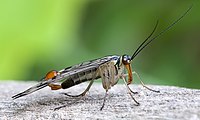
Photo from wikipedia
Simple Summary Understanding the macro pattern and mechanisms of variation in species diversity along environmental gradients is one of the most important objectives in ecology. However, there have been few… Click to show full abstract
Simple Summary Understanding the macro pattern and mechanisms of variation in species diversity along environmental gradients is one of the most important objectives in ecology. However, there have been few large-scale studies on the specific mechanisms by which climate and human activities affect insect diversity along the ecological transect. This study revealed the diversity patterns of insect communities along the ecological transect in the Eastern Eurasian Temperate Steppe, investigated the effects of environmental factors on its diversity in two types of steppes, and assessed the influence of plant diversity alterations on these effects. Our results revealed a breakpoint of insect diversity that divided typical and desert steppe communities. Climate factors and grazing intensities combine to influence insect diversity along the transect, and these effects are mediated through plant diversity. These findings provide a reference for the diversity patterns of insects along ecological gradients in the Eastern Eurasian Temperate Steppe and different conservation strategies of biodiversity in typical and desert steppes. Abstract Insects are important components of biodiversity and play significant roles in the steppe ecosystem. They are abundant, easy to sample, and sensitive to changing conditions, making them useful indicators of environmental changes. This study aims to describe patterns (α and β) of insect diversity across two steppe types (a typical steppe and a desert steppe) along the Eastern Eurasian Steppe Transect (EEST), as well as evaluate the effects of environmental variables in determining these patterns and the influence of plant diversity alterations on these effects. To this end, we collected 5244 individual insects and found an n-shaped diversity distribution along the latitudinal gradient and a significant difference in insect communities across the two steppe types. Further, the Mantel test and path analysis indicate that climate and grazing activities combine to influence insect diversity, and these effects are mediated through plant diversity, strongly supporting the role of bottom-up effects in situations of climatic and grazing pattern changes. Moreover, the contribution of plant diversity varied with steppe types and insect functional groups, with greater effects seen in the typical steppe and herbivorous insects. This indicated the importance of protecting species diversity in steppes through managing plant diversity and assessments of local environmental factors such as grazing intensity and temperature.
Journal Title: Insects
Year Published: 2023
Link to full text (if available)
Share on Social Media: Sign Up to like & get
recommendations!